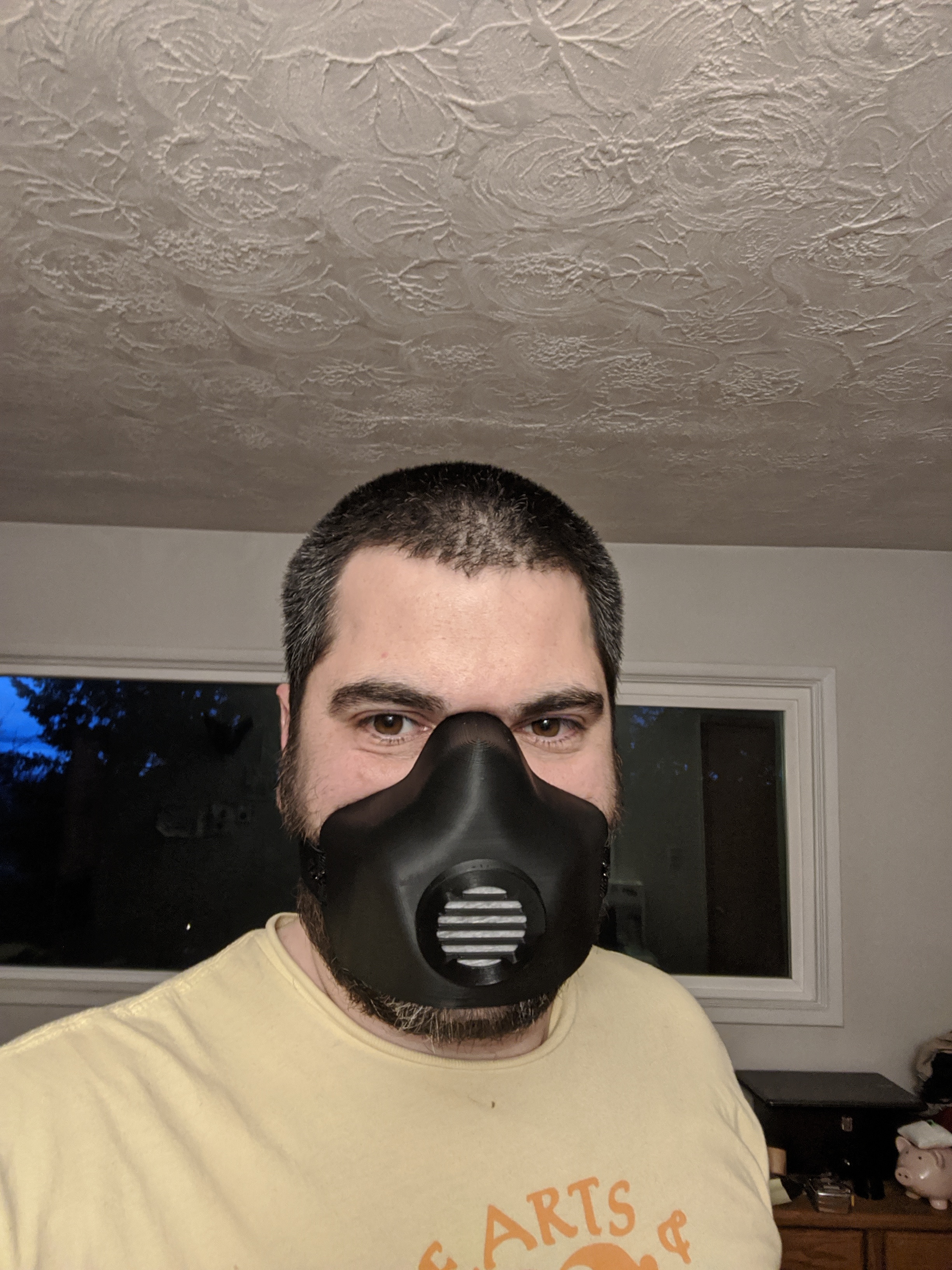
WARNING: This is not meant to guarantee full protection against COVID-19 since the filter to be installed is up to the owner. Remember that effective filters are FFP3.
The mask is aimed to stop the public from mass purchase of masks that shall be reserved to medical staff.
Items required:
Sealing strip (foam like – neoprene) / Suggested thickness 10 mm
Chin piece L = 14cm
Face piece L = 23.5cm
I designed with a quite large space on the nose area and without a bottom layer in order to adapt to most of the faces. The one in the picture is printed in PLA (I would suggest to try TPU as well).
I used thin silicone windows seals (5 x 5 mm) and already with this the sealing is perfect. If I close the front opening with hands it is basically impossible to breath.
By using a thicker foam strip I believe that optimal sealing can be achieved on most of the faces.
Print it and any suggestion is welcome.
Remember: Print it for you, your friends and whoever and do stop buying professional masks. Medical staff seriously needs them.
PS. I suggest to print is as in the picture since that orientation requires minimum supports.
If you need the sliced file, text me.
EDIT 23.03.2020
Filter cap added.
Depending on the printer settings and precision, the cap the be just clicked in/out or (if it’s loose) clockwise rotated for plug-in (end stroke present). I suggest a thick filter that will guarantee a better sealing and will make the click-in enough.
EDIT 25.03.2020
Added inner neoprene sealing band 10mm x 10mm. The sealing level with the face is perfect and comfort increased. Working on some effective filters alternative at the moment. Will keep you posted.
EDIT 26.03.2020
Created one-page website to ease distribution.
https://3dsprint.wixsite.com/printable-respirator
EDIT 27.03.2020
Chin area modified to better adapt to different faces. Already tested on male/female faces of different sizes. Print it, test it, leave a feedback on the website comment area! Thank you for contributing to the development.
EDIT 29.03.2020
Added YouTube tutorial on website to guide people through correct assembly)
EDIT 31.03.2020
Reduced thickness to 1.2mm (3 printing layers for optimal elasticity on the sides without compromising filling) – Print time reduced by 1h (with 0.4mm nozzle)
Slightly increase of front intake area.
EDIT 02.04.2020
Added Filter_Cap_50 with inclined inflow channels.
If you are using a HEPA filter or a piece of cotton, I suggest to use the file Filter_Cap_50.
The slots for air intake are inclined of 50° in order to deviate the intake velocity of the flow.
In this way air is forced to enter with an intake angle in the filtering media (rather than perpendicularly) crossing more useful filter volume and helping filtration by diffusion.
It won’t make it become a super effective filter and it’s a free contribution.
Other advantage is that the projected surface exposed to drops (if someone is in front of you) is virtually 0 (remember that ideally you want a DYI mask to be a shield more than a filter).
Breathability is not affected since total intake area is similar to the other version.
NOTE: Many DYI masks present a wide intake area in order to reduce the pressure drop and increase the filter efficacy.
This makes sense for high level filters, such as FFP3/FFP2 which need to have a wide intake surface (the whole mask) since they capture the virus particles by different mechanics (such as interception and impaction) which are badly influenced by pressure drops.
These 3D printed masks or dyi masks won’t probably have that type of filter, but rather some cottons, fabrics or best case HEPA. Considering this last case (best solution), a standard one has a good filtration level with airflow up to 100 times the one of human breath. Moreover HEPA filters show a certain efficacy against viruses since they filter by diffusion which is a different mechanics, effective especially with low airflow (such as human breath).
This is the reason why for 3D printed masks with homemade filters (to be used as last resort instead of pieces of clothes) I believe it is a better approach to keep the intake area as small as possible (always taking into account the ratio with the nose intake area).
I see a 3D printed mask with homemade filters primarily as a shield and only secondarily as a low efficacy respiratory filter.
This article was first featured at https://ift.tt/2wYmVX4 on April 2, 2020 at 11:19PM by LuNdreu






More Stories
Can this possibly be true? “Metal 3D printing is now possible on any 3D printer…with the right settings and a few minor upgrades like a hardened steel nozzle…” – July 2 2023 at 04:59PM
New NASA Funding Ignites 25 3D Printing Projects in Space Exploration – June 18 2023 at 04:34PM
Nvidia AI produces 3D models from 2D videos 3D printing applications forthcoming? – June 15 2023 at 02:55AM